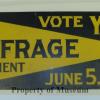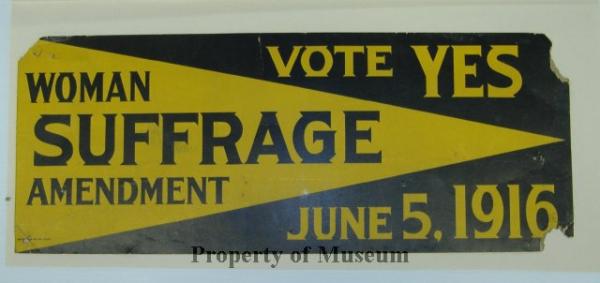Propaganda and Women's Suffrage
| Grade | 9th -12th Grades | Class | Social Studies | Length of Lesson | 1 hour |
| Lesson Title | Propaganda and Women's Suffrage |
| Unit Title | The 20th Century in Iowa |
| Unit Compelling Question | How did Iowa experience the 20th century in comparison to the nation? |
| Historical Context: The Fight for Women's Suffrage It was a long and difficult struggle. But finally in 1919 women in Iowa-and across the country-celebrated the passage of the 19th Amendment to the U.S. Constitution. At last women were allowed to vote! The passage of the amendment for women's suffrage meant that women all across the country could vote for the president, senators, governor, mayor and local school board members. When the news reached Iowa many women and men in the state said, "It's about time!" The first public proposal for women's suffrage occurred at a women's rights convention in Seneca Falls, New York, in 1848. While some people favored it, most people ridiculed the concept of women taking a role in public affairs. Individuals against a woman's right to vote would say that a woman's role was in the home, they argued, taking care of her family. She should not be required to involve herself in politics or discussion of public issues. They also argued that most women did not want to vote and granting women the vote would create tension within the family. In 1868 there was talk about changing the wording of the Iowa Constitution as it related to who could vote. And in fact, the wording was changed. The Iowa lawmakers took out the word "white" in the sentence that described who could vote in Iowa. They left the word "male" in the sentence. This change gave black men the right to vote in Iowa. But women still weren't allowed to vote. Two years later in 1870 the 15th Amendment to the U.S. Constitution made it illegal to deny the right to vote to black men in all states. Many people were happy for black men, but they were disappointed for women. The first woman suffrage association was formed in Dubuque in 1869. Local suffrage organizations were started all over the state after 1869. These groups met to hear speeches about women's rights and to learn how to get a law passed to allow women to vote. The first state women's suffrage convention was held in Mt. Pleasant in 1870. After this more and more speeches were given around the state about women's suffrage. Many newspapers carried articles about the issue. Church members and ministers became involved in the discussion. The Struggle in Iowa The Iowa Constitution had to be changed in order to allow women to vote. It takes quite a long time to make changes to the Constitution. Any change or "amendment" requires two legislatures to vote on the amendment. And the legislature at that time met only every two years. So, if an amendment was proposed in one year, it was another two years before the legislature met again to talk about it. That's one reason the passage of a women's suffrage law took so long. But it wasn't the only reason. Not everyone was sure that women should vote. In order for the amendment to become law after the legislature passed it, the voters of the state had to vote in favor of the amendment. In 1870 a women's suffrage bill passed both the Senate and the House of Representatives in the Iowa legislature for the first time. But when the legislature met the next time-in 1872-the amendment didn't pass. This happened several times over the next 50 years. Often women's suffrage was tied to other political issues, especially the sale of alcoholic beverages. Most people believed that women with the vote would favor restricting or even eliminating saloons or other places where beer, wine and alcoholic drinks were sold. To a large extent, those who favored prohibiting such places from operating favored giving women the vote. Those who wanted less restriction opposed women's suffrage. Some churches like the Methodists, Presbyterians and Baptists were often very strong in their support of granting women the vote. In 1894 the Iowa legislature granted women the right to vote in some cases. They were granted "partial suffrage." The constitution defined who could vote in elections. And elections were defined where candidates ran against each other for public office. However, sometimes voters voted "yes" or "no" on issues, like building a new school or library. After 1894, women were allowed to vote on issues where there were no candidates but they were not allowed to vote to elect public officials. In 1916 the state legislature approved an amendment to the constitution that would have granted women the same rights men had, to vote in all elections. To become part of the state constitution, however, the proposal had to be approved by the voters of the state. To the great disappointment of those who favored women's suffrage, the proposal failed to win a majority. However, victory was only a few years away. Federal Law Passes In 1919 Congress approved an amendment to the United States constitution and submitted it to the states. It would become law when three-fourths of the states, 36 states at that time, ratified (approved) it. Tennessee became the thirty-sixth state in the summer of 1920, and women voted in the general election in the fall to elect a president, vice president, congressmen, and state and local officials. It had taken nearly 75 years since women's suffrage was first proposed in Seneca Falls, New York, in 1848. Iowa Suffrage Leaders Some of the same people who had fought for passage of an amendment in Iowa worked at the federal level to win passage of the federal law. Elizabeth Cady Stanton, Mary Jane Coggeshall and Amelia Bloomer were Iowans who worked at the national level to win the right to vote for women throughout the United States. One Iowan-Carrie Chapman Catt-was a key player in the fight for women's rights at the national level. She was president of the National American Woman Suffrage Association, an organization that was instrumental in winning passage of the 19th Amendment to the U.S. Constitution. She also helped organize the International Woman Suffrage Alliance, which supported women's rights in over 30 countries. The issue of women's right to vote was fought and won in the nation's capital and in small towns and rural areas of Iowa. It was an issue that affected men and women in all parts of the country in the late 1800s and early 1900s. The events that occurred and the people who made them happen had a lasting impact on life in Iowa. Sources Schwieder, Dorothy. Iowa Past to Present: The People and the Prairie. Ames, Iowa: Iowa State Press, 2002. |
|
| Lesson Supporting Question | |
| Lesson Overview | Students will examine images or propaganda from the American Woman's Suffrage Movement and will 1) examine the role of imagery within the Women's Suffrage Movement and 2) the tactics American Suffragettes used by comparing their movement with similar movements in different states and countries and how they were examples of why women should have equal voting rights. |
| Primary Sources Used |
|
| Resources Needed | Intro Video: https://www.youtube.com/watch?v=_UNxoJHLumU&feature=youtu.be https://www.youtube.com/watch?v=PNlCS85FVmU 1. https://iowaculture.gov/history/education/educator-resources/primary-source-sets/womens-suffrage/anti-suffrage-ad-iowa 2. https://iowaculture.gov/history/education/educator-resources/primary-source-sets/womens-suffrage/sky-now-her-limit-political 3. https://iowaculture.gov/history/education/educator-resources/primary-source-sets/womens-suffrage/excerpts-are-women-people 4. https://iowaculture.gov/history/education/educator-resources/primary-source-sets/womens-suffrage/votes-women-broadside |
| Standard | |
| Lesson Target | Students will analyze primary sources and decipher their hidden meanings.;Students will be able to examine how primary sources could be used to study history and gather historical evidence to form a claim.;Students will be able to evaluate whether propaganda was effective for US women in gaining the right to vote.;Students will be able to compare and contrast the Women's Suffrage Movement of the early 20th century within Iowa, the nation, and the globe. |
| Lesson Themes | Civil Rights, Women's Experience |
|
| Formative Assessment (How will you use the formative assessments to monitor and inform instruction?) |
Students can write a free response answering the question: 'Was the use of propaganda successful in gaining the right to vote for women?" |
| Summative Assessment (How does the lesson connect to planned summative assessment(s)?) |
Students can write an essay on the topic and cite their evidence using the primary sources provided in class. |
| Author | Natalie Berry, Dr. Heidi Lung | Created | Last Edited | ||||
| Reviewer: Dr. Heidi Lung, University of Iowa | |||||||
| Lesson Plan Development Notes: Museum Studies Program, The University of Iowa | |||||||


